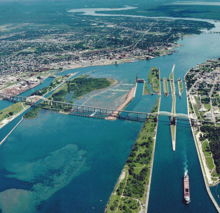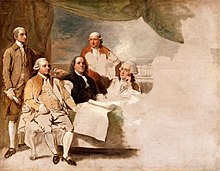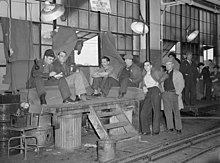User:Dana boomer/Sandbox2

The History of Michigan is divided into the following articles.
See also Timeline of Michigan history.
Before 1776
[edit]

The first recorded white man to see what is now Michigan was a Frenchman, Etienne Brule, who explored what is now the Upper Peninsula around 1610.[1] More what men began to enter the area during the mid-17th century due to the French fur trade. These men included both the fur traders and the Jesuit missionaries that followed them. In 1641, the Jesuits were ministering to around 2,000 Indians near what is now Sault Ste. Marie, and in 1667 established a mission there. Within the year, a town began to grow around the mission, and Sault St. Marie is now the oldest permanently occupied settlement in the state.[2] A prominent person in the early history of Michigan is Jacques Marquette, a Jesuit priest. Originally assigned to the Sault St. Marie mission in 1668, he was then moved to the La Point Mission in Chequemagon Bay. Due to trouble with the Sioux indian tribe, he moved his congregation to a small trading post at Michilimackinac and established a new mission - later to be called St. Ignace.[3]
By the late 1600s, there was an overabundance of furs moving from the French "high country", including what is now Michigan. This resulted in low fur prices and product rotting in warehouses due to the expense of sending it to Franch. In 1696, French king Louis ordered all soldiers and traders back to Canada.[4] After the king's edict, Sieur Antoine de La Mothe Cadillac, a French army commandant, protested to the Canadian governor and the king himself that it would be more beneficial to Franch to turn the Michigan area into a true colony. The king agreed, and in 1701, Cadillac led a party of soldiers, artisans, traders and priests to southern Michigan to build Fort Ponchartrain and found the city of Detroit.[5] By the mid-18th century, Detroit countred 80 buildings and, including neighboring farms, 1500 European inhabitants.[6]
In the meantime, Fort Michilimackinac, built near the St. Ignace Jesuit mission, had fallen into disrepair after the French withdrawal, and had been occupied by French traders operating outside of the law, illegally trading brandy for furs with the Indians. In 1715, in an attempt to fortify the north country against the English, the fort was re-established.[7] In the late 17th century, Robert Cavelier, Sieur de La Salle, had built a fort near St. Joseph, naming it Fort Miami.[8] By the early 1700s, the first children in Michigan were being born here, at the renamed Fort St. Joseph, and 50 families were recorded to live there as of 1750.[9]
In 1755, large scale warfare erupted between Franch and England in the French and Indian War. Within two years, the English took Quebec and Montreal, and the French surrendered. The land that is now Michigan now belonged to the British. In November of 1760, Detroit was handed over to the British, and by the end of 1761 they had taken control of all other French forts in Michigan.[10] However, France and England were still at war and the Indian tribes in Michigan were friendlier with the French than the British.[11] In 1763, Indian tribes beseiged Fort Detroit, St. Joseph was taken, the fort at Sault Ste. Marie had been destroyed by an accidental fire before the war, and Fort Michilimackinac was taken and most of its garrison killed. In the same year, the French and the British made peace, and eventually the Indians turned the forts they had taken back over to the British.[12]
From 1776 to 1837
[edit]
The American Revolution at first had very little impact on what is now Michigan. Most of the population was made up of Indians and French settlers, and what British soldiers were there were almost completely unaffected. However, in 1778, revolutionary troops struck deep into the Illinois territory and took several British forts. British troops from Fort Detroit responded, marching across lower Michigan and Indiana to engage the revolutionaries. However, the Americans were victorious, and when the peace treaty was written, the northwest territory belonged to the newly independent colonies.[13] During the fighting in Illinois, Spanish troops from west of the Mississippi River briefly captured and held Fort St. Joseph, giving Niles (the town where the fort was located) the distinction of being the only town in Michigan to be under four different flags - American, British, French and Spanish. In 1780-81, fearful of an American attack, the British destroyed the existing Fort Michilimackinac and built a new one on Mackinac Island.[14] Despite the end of the war having given Michigan to the Americans, the British did not evacuate their posts in Michigan, and continued funding nearby Indians in their attacks against the Americans. However, in 1794, American troops dealt a large blow to the Indians in the Battle of Fallen Timbers, and the British soon removed their troops from Michigan forts.[15]
The Michigan Territory was created by Congress in 1805. At this point, the Mackinaw Company controlled most of the fur trade in Michigan. In 1808, John Jacob Astor organized the American Fur Company and soon began buying into the Mackinaw Company, gaining the controlling interest in six years. Around this same time, General William Hull, the governor of Michigan and commander of US forces at Detroit, called a meeting of local Indian tribes and convinced them to trade all land east of a line drawn north-south twenty miles to the west of Lake Erie's west end, in exchange for $10,000 and various annuities.[16]
America's claim to Michigan was challenged in the War of 1812, when the British and their Indian allies easily took Detroit, as well as most of the land to the west. Fort Mackinac was taken by the British without bloodshed.[17] However, after Oliver Hazard Perry's victory on Lake Erie, breaking the British naval stronghold there, Britain's hold on Michigan was broken, and they soon evacuated Fort Detroit. The Americans soon retook all of the lost land in Michigan.[18] After the war, the US government made two decisions that would hugely accelerate the pace of Michigan's growth. First, is appointed Lewis Cass governor of the Michigan territory. This put into place a governor who firmly believed that Michigan should be made prosperous through population and development. He was instrumental in acquiring large portions of land from the Indians, having it properly surveyed, and then distributing it to settlers. The second decision made by the government was to declare that only Americans could participate in the fur trade on US soil. This made it possible for Astor's American Fur Company to exploit the natural fur resources of Michigan. By destroying the populations of fur-bearing animals, Astor also made it easier to convince the Indians to sell their land and leave the territory.[19]
Governor Cass's job was made harder by the fact that many of the reports being given to potential settlers by the federal government played down the benefits of the state, reporting that the entire territory consisted of swampland, mixed with lakes and sand. When a fort was built near present-day Saginaw, almost the entire garrison came down with malaria, and soon the post was abandoned.[20] However, in 1825, the Erie Canal was opened, which made travel and trade between Detroit and the eastern parts of the nation much easier. At first, furs were the only good shipped from Michigan to the eastern states, but within 15 years, large amounts of wheat, flour, whiskey and lumber were moving eastward.[21] The larger numbers of settlers moving into and through Michigan also countered some of the prevailing opinions on the state - parts of the state that were not swampland were discovered by settlers, and these settlers raved about the beauty and productivity of the state.[22] In 1836, it was reported that between early spring and late autumn, a wagon left Detroit for Michigan's interior every five minutes between dawn and dusk.[23] In 1824, less than 62,000 acres of Michigan had been sold to private citizens; the year after the opening of the Erie Canal, almost 1.5 million acres had been sold around Detroit alone. Small cities such as Ann Arbor, Kalamazoo, Battle Creek and Grand Rapids were founded, and the population boomed.[24]
In 1834, a border dispute began to boil between Michigan and Ohio over a small piece of land on the border between the two states. Although officially governed by Michigan, the piece included a harbor on Lake Michigan that Ohio claimed as its own. Militias were organized and state funds appropriated to back up each state's claim. The problem was sent to the federal government, and President Andrew Jackson sent commissioners to peacefully settle the issue. However, these commissioners failed to make a difference, and after Michigan governor Stevens Mason arrested several Ohio officials, Jackson had him removed from office. Congress asked for Michigan to give the disputed area to Ohio, in exchange for the then-little known Upper Peninsula. After the installion of a federally-appointed governor, Michigan declared itself a state, based on population numbers higher than the minimum required by the federal government for statehood. Congress declined, based on the unresolved border conflict, and so the state of Michigan was essentially a sovereign state, existing outside of the United States government. A solution was found - Michigan was offered $400,000 from a surplus in the US treasury being distributed among the states, but only if she accepted the compromise and took the Upper Peninsula, thus allowing Congress to declare her a state.[25]
From 1837 to 1941
[edit]
In January 1837, full statehood was granted to Michigan, including both peninsulas.[26] The state of Michigan continued to buy land within its borders from the Indians, and by 1842, the title to all land within the state boundaries had been acquired.[27]
During the spring of 1837, the first steam-powered railroad west of the Allegheny Mountains began operation.[26] This railroad provided for further expansion of settlers within the state, and within the year the legislature had provided for three more railroads to be built across the Lower Peninsula.[28] A new resource in the state also began to be developed: lumber, especially in the Muskegon area, on the western side of the state. The resource had been noticed before, by Frenchmen in the 1600s and again when a trading post was established in the area in the early 1800s. Finally, in 1837, a sawmill was established at the mouth of the Muskegon River and the lumbering era of Michigan began. The newly booming city of Chicago and westward expansion provided large markets for the lumber.[29] However, the natural resource policies of the time were not focused on maintaining the resource. The main aim of the lumbering was to clear the land for farming, to extend Michigan's existing agricultural belt, and so the trees that were cut were never replaced. Many small villages, many of which survived off of fishing and fur trading, were to become boom-towns during the lumber era, including Alpena and Menominee.[30]
Estimates place the dollar value of the lumber extracted between 1847 and 1907, when the boom was at its peak, at over a billion dollars greater than the amount of gold mined in California during the same time. This huge industry, and the need to transport the logs, pushed the construction of rail lines and cross-state canals, financed through state-issued bonds and the sale of state lands. However, the late 1830s saw the financial and real estate markets bust, which led railway and canal companies to stop construction.[31] In the early 1840s, this trend reversed and the railways again began to grow, with more people wishing to travel and ship goods at ever increasing speeds.[32] In the mid 1840s interest in steam-powered sawmills grew, and in 1847 the first shipment of pine from the Saginaw Valley was made through the use of a steam-powered mill capable of producing three million board feet of lumber annually. This new technology, combined with the high quality of Saginaw pine, led to the building of more mills, and soon there were 14 mills in Saginaw, which in 1854 produced sixty million board feet of lumber. Subsequent improvements in cutting technology made it able to produce increasing amounts of lumber in less time.[33] After 1856, the largest wholesale center for finished lumber moved from Albany, New York to Chicago, from which it was distributed to the huge numbers of new immigrants into the area, allowing further growth in Michigan's lumber market. The new technologies that came into being due to lumbering brought into Michigan men skilled with technology, and from there, these men built factories that turned towns such as Grand Rapids and Pontiac into centers of buggy and carriage making; Bay City, Port Huron and Grand Haven into shipyards, and Saginaw into a producer of railway cars. These changes brought the first steps of industrialization into Michigan, and helped towns begin to turn away from their dependence on the lumber trade. Railroads also helped areas with pine trees but no waterways to float the logs to sawmills, such as Clare and Cadillac, enter the lumber market, and the introduction of narrow-gauge railways to Michigan in 1876 further increased the amount of accessible timber.[34]
The Upper Peninsula was beginning to grow during this time as well, as a copper boom began in 1843. The Indians, Jesuits and fur traders had known about the copper riches for years, but the rush to mine it did not begin until the 40s. Although many individuals went expecting to make their fortune as the gold miners in the western United States did, few met their expectations. Copper was not as valuable as gold and was more likely to be found underground, mixed with worthless rock. Also, all copper mined in the UP had to be portaged over the falls at the Soo, due to the failure of an earlier plan to build a canal through the straits. Despite these problems, many Upper Peninsula towns came to be, or expanded rapidly, because of the copper boom, including Copper Harbor, Ontonagon and Eagle Harbor.[35] After the first group of gold-rush-type prospectors had left, the businessmen who were left, who were those with the capital and technical knowledge to make the venture profitable, prospered on the mining of copper and iron ore found during land surveys. However, transportation was as much as problem with these metals as it was with the lumber in the southern part of the state. Several means of shipping were tried, but the bottleneck at the Soo proved a major hurdle to efficient transportation, and the plans for a canal were revived. Although beginning as a state operation, it eventually became an operation of the federal government due to the costs and engineering involved. Locks larger than some thought were needed were built, in order to handle the larger ships that others realized would come with the prospects of huge amounts of natural resources to carry, and in 1855 the Sault Ste. Marie Canal was opened. The resulting immense increase in copper and iron ore production led to the creation of new towns, expansion of railway lines and the immigration of settlers from abroad, especially miners from Cornwall who significantly influenced the population of the UP.[36]
In 1861, when the American Civil War began, Michigan entered on the side of the Union. Michigan sent 87,000 men into the war, and 14,700 were killed.[37] Throughout the 1870s, railroads continued to be built throughout Michigan, and in 1881, in an effort to boost population in the lands recently opened to settlers by the railroad, Governor David Jerome announced that immigration bureaus would be set up and railroad companies expected to canvass immigrants from around the world to settle into the new farmland. However, in 1885 the policies were reversed, as increased immigration had caused unemployment and over-crowding in the state. Also in 1885, major strikes closed sawmills in Bay City and Saginaw, with workers demanding fewer hours for the same pay. In 1887 immigration was further curbed by Governor Russell Alger, who stated that immigration brought "bad people of all classes and conditions" into the state. Despite all this, immigration continued.[38] Since the War of 1812, immigrants from around the world had provided the labor base on which the state was built. Men from Cornwall in the mines, Scandanavians in the lumber camps, Dutch in the southern farmland, Germans and Italians in the southern shops and factories and Irish in every profession had given the labor to build the state to its current prosperity.[39] Both current residents and immigrants felt that once the pine trees were removed from the northern parts of the state, the soil would prove to be as fertile as that in the south; this proved not to be true, and after the lumber was gone, railroads slowly went bankrupt, towns and farms were abandoned and nature began to retake the land. However, vacationers and sportsmen began to find the north, and as early as 1882 Crooked Lake was applauded by fishermen.[40] At the same time, the southern part of the state was beginning to expand into an industrial powerhouse. In 1860, the southern third of the state had not quite 2,500 manufacturing establishments worth $28 million; by 1900 this number had expanded to more than 16,000 factories worth $284 million.[41]
After 1941
[edit]
See also
[edit]- Algonquian peoples
- European colonization of the Americas
- North American French and Indian Wars
- History of Detroit
- History of Ford Motor Company
- History of General Motors
- History of the Midwestern United States
- History of the United States
- International Boundary Waters Treaty
- Inland Northern American English
- Northwest Ordinance
- List of Michigan county name etymologies
- List of museums in Michigan
- Native Americans in the United States
- Sixty Years' War
- Timeline of Michigan history
- Timeline of the Toledo Strip/War
Notes
[edit]- ^ Catton, Michigan: A History, pp. 4-5
- ^ Catton, Michigan: A History, pp. 8-10
- ^ Catton, Michigan: A History, pp. 10-12
- ^ Catton, Michigan: A History, pp. 19-20
- ^ Catton, Michigan: A History, pp. 20-21
- ^ Catton, Michigan: A History, p. 32
- ^ Catton, Michigan: A History, p. 26
- ^ Catton, Michigan: A History, p. 17
- ^ Catton, Michigan: A History, p. 29
- ^ Catton, Michigan: A History, pp. 32-35
- ^ Catton, Michigan: A History, p. 43
- ^ Catton, Michigan: A History, pp. 46-49
- ^ Catton, Michigan: A History, pp. 51-54
- ^ Catton, Michigan: A History, pp. 54-55
- ^ Catton, Michigan: A History, pp. 56-57
- ^ Catton, Michigan: A History, pp. 58-60
- ^ Catton, Michigan: A History, pp. 61-62
- ^ Catton, Michigan: A History, p. 64
- ^ Catton, Michigan: A History, pp. 64-65
- ^ Catton, Michigan: A History, pp.71-72
- ^ Catton, Michigan: A History, p. 73
- ^ Catton, Michigan: A History, p. 76
- ^ Catton, Michigan: A History, p. 79
- ^ Catton, Michigan, A History, p. 83
- ^ Catton, Michigan: A History, pp. 90-93
- ^ a b Catton, Michigan: A History, p. 93
- ^ Catton, Michigan: A History, p. 69
- ^ Catton, Michigan: A History, p. 96
- ^ Catton, Michigan: A History, pp. 100-101
- ^ Catton, Michigan: A History, pp. 101-103
- ^ Catton, Michigan: A History, p. 108
- ^ Catton, Michigan: A History, p. 110
- ^ Catton, Michigan: A History, pp. 130-132
- ^ Catton, Michigan: A History, pp. 143-146
- ^ Catton, Michigan: A History, pp. 115-117
- ^ Catton, Michigan: A History, pp. 118-123
- ^ Catton, Michigan: A History, p. 149
- ^ Catton, Michigan: A History, pp. 152-155
- ^ Catton, Michigan: A History, pp. 155-156
- ^ Catton, Michigan: A History, pp. 156-158
- ^ Catton, Michigan: A History, p. 184
References
[edit]- Catton, Bruce (1984). Michigan: A History. New York: W.W. Norton & Company. ISBN 0393301753.
